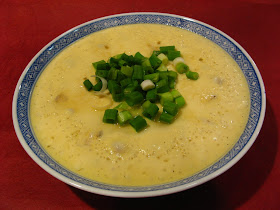Happy New Year to everyone! For my first recipe of the year,
here’s a quick cooking (and it’s really easy to make) steamed egg custard dish
using scallops. The classic Chinese-American dish uses ground pork instead of
scallops. I can’t take credit for substituting scallops for pork, since I got
the idea from a restaurant menu. I also found out that one pound of frozen scallops yields one-half pound thawed, so be sure to use enough thawed scallops in this dish. I’ve also had a version of this dish using clams
in their shells, so there must be more variations that I haven’t run into yet.
The taste of this dish is greatly influenced by the quality
of the stock used to scramble the eggs. The dish will taste different if canned
or homemade stock is used, so I try to use homemade stock from the Bone Soup
(湯, Tong1) recipe whenever
possible. Since scallops are such a luxurious ingredient, using homemade stock
is a must in my mind. The scrambled egg mixture needs to cover the scallops.
The amount you’ll need depends upon the size of the scallops used and the size
of the steaming plate. The classic recipe uses 2 eggs and ½ cup (250 ml.) of
stock, but in this case I needed more egg mixture to cover the scallops, so I
increased the recipe to 3 eggs and ¾ cup (375 ml.) of stock. All the air
bubbles need to be removed from the egg mixture after pouring onto the scallops
or the surface won’t be smooth once it’s steamed. I’ve seen some recipes where
the egg mixture is strained or the bowl is covered with aluminum foil before
steaming to prevent any water from settling on the egg custard surface (which
mars the cooked surface). I don’t bother to strain or cover the egg custard
while steaming, but they are options you can consider.
Enjoy!
Ingredients
|
½ lb.
|
250 g.
|
Scallop meat (扇貝, sin3
bui3)
|
|
½ tsp.
|
2.5 ml.
|
Ground white
pepper (白胡椒, baak6 wu4 ziu1)
|
|
1 tsp.
|
5 ml.
|
Sesame oil (麻油, maa4 jau4)
|
|
|
|
|
|
3
|
3
|
Eggs (雞蛋, gai1
daan6), scrambled
|
|
¾ cup
|
375 ml.
|
Chicken stock (湯, tong1)
|
|
1 Tbs.
|
15 ml.
|
Shaoxing rice
wine (紹興酒, siu6 hing1 zau2)
or dry sherry (optional)
|
|
¼ tsp.
|
1.25 ml.
|
Salt (鹽, jim4)
|
|
½ tsp.
|
2.5 ml.
|
Sesame oil (麻油, maa4 jau4)
|
|
|
|
|
|
1 stalk
|
1 stalk
|
Green onions (葱, cung1), cut into ½-inch (15 mm.) pieces
|
|
|
|
|
|
|
|
Water for
cooking
|
|
|
|
Oyster or
abalone sauce for topping (optional)
|
Equipment
|
12 in.
|
30 cm.
|
Steamer (or larger)
|
|
9 in.
|
23 cm.
|
Plate or bowl for steaming
|
|
|
|
Plate lifter
|
Instructions
- If using frozen scallops, thaw in a covered container overnight in the refrigerator. Take the scallops out of the refrigerator at least one hour before cooking and mix together with the ground white pepper and sesame oil. Place the scallops in one layer into the steaming plate.
- Scramble the eggs in a bowl, together with the chicken stock, Shaoxing rice wine or dry sherry (optional), salt, and sesame oil. Pour the mixture carefully into the steaming plate to cover the scallops. If possible use a homemade stock, such as from the Bone Soup (湯, Tong1) recipe, since the taste of the dish is greatly influenced by the quality of the stock used to scramble the eggs.
- Gently shake the steaming plate to cause any air bubbles to rise to the surface and skim the bubbles off. In order to produce a smooth egg custard surface, the air bubbles must be removed before steaming.
- Wash and cut the green onions into ½-inch (15 mm.) pieces.
- Add water to the steamer, cover, and bring to a boil over high heat. Uncover the steamer, add the steaming plate to the steamer, cover, and reduce the heat to low. Simmer for 10 minutes, turn off the heat, and let the covered steamer sit for 5 minutes to set the eggs.
- Remove the steamer plate using a plate lifter from the steamer and top with the green onions. The egg mixture can also be optionally topped with oyster or abalone sauce. Serve the dish with steamed rice.


No comments:
Post a Comment